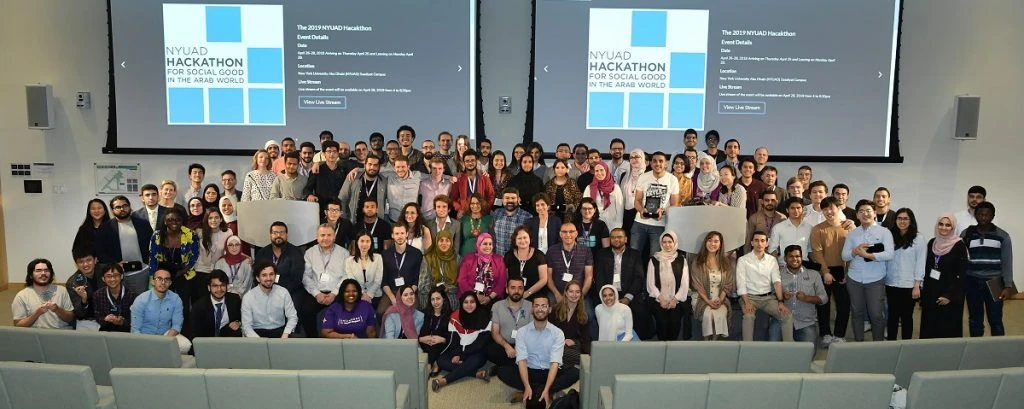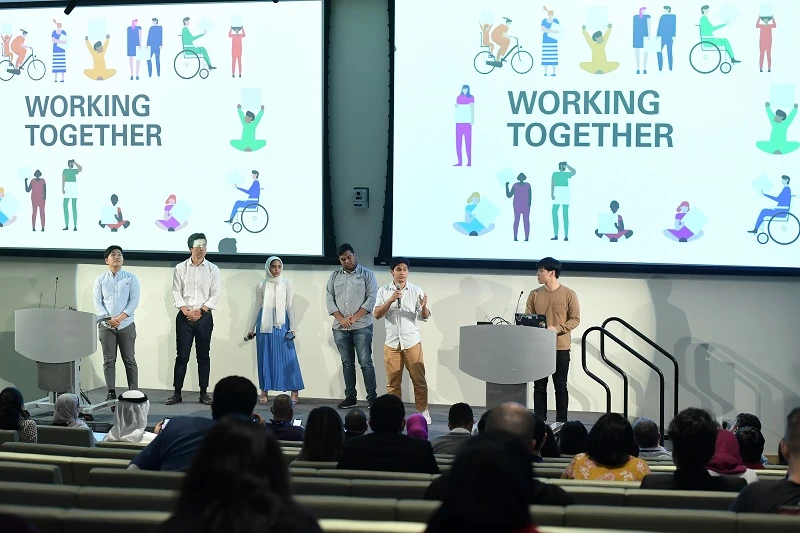“Have a powerful idea, a story you can explain, and a good solution”: Tips from the Annual NYUAD International Hackathon
June 25, 2019

Mark Wood, Engineering Manager in the Mobile Team at Bloomberg London, recently returned from the 8th Annual NYU Abu Dhabi (NYUAD) International Hackathon for Social Good in the Arab World. Just like last year, Wood judged the 2019 competition. His advice for future attendees is clear enough: “If you can prepare for anything, it’s the idea.”
This year’s event was attended by more than 80 students from over 50 nationalities. If diversity is what makes the event special, combine that with its core purpose – achieving social good in the Arab world – and you’re left with something truly unique.
Wood was in Abu Dhabi alongside Kassem Wridan, an iOS Engineer also based out of Bloomberg London, who, like Wood, reprised his 2018 role as a Mentor at the event. Wridan’s team, Hukamaa, built upon an idea to tackle loneliness among the elderly by developing a platform that could connect older and younger generations.
“The elderly are wise; they have gathered a lot of experiences throughout their lives and careers. It’s a shame that isn’t shared with the younger generations who will eventually go through the same life experiences,” says Wridan. “The team’s platform looked to change this through two angles: creating volunteering opportunities for young people with the elderly, and changing perceptions of the elderly.”

Hukamaa came in joint for second at this year’s event – an achievement Wridan rightly described as “awesome.” He attributes the team’s success to three reasons: “First is that the team got along really well. The second is that it was a great idea. And the third is that they were all amazing presenters. They put a really nice story into their presentation. Judges rate not only your idea, but also how you sell it.”
As both are now regular participants in the Abu Dhabi competition in their respective roles, it’s safe to say that Wridan and Wood have a few pearls of wisdom to impart to anyone looking to attend this – or really any – hackathon. So, we sat down with them both to hear their dos, their don’ts, and to simply ask what someone can gain from attending one.
Why sign-up?
“Just go for it,” states Wood, when presented with that question. “It’s not about going there and winning. It’s about the collaborative experience and learning from that, in terms of both soft skills and technically.”
“The experience of working in a team is a great thing to get out of a hackathon,” adds Wridan. “Another is having the experience of focusing on the bigger picture as part of a team. At university, you’ll commonly just be focusing on you and your own work, so it’s a real change from that.”
Alignment and iteration
Much is made about the technical and physical challenges of a hackathon, which is undoubtedly justified. But softer skills play an equally important role.
“Overcommunicating is key,” states Wood. “Communicating is one thing, but in a hackathon, where time is at a premium, you have to communicate more than you usually would to make sure you’re all aligned and working on the right things. Don’t leave too much room for interpretation.”
“Every year, I’ve seen teams fail to get aligned on their idea at the early stages of the process,” says Wridan. “People within a team will often have different views on how the idea can be brought to life, but misalignments can be very hard to recover from.”
“Make sure you have something that works end-to-end,” Wood adds. “Keep it working and iterate.”

Good teamwork is more than good communication
With groups split into small teams in Abu Dhabi, having the ability to work well in that team setting is important. Good communication is a key feature of good teamwork, but not the only one, as Wood explains.
“Collaboration also means being aware of your team. If you see someone on your team hitting an issue, don’t let them struggle – try to be helpful. Everyone will bring something unique to the table; as a group, you have to figure out what that is and how to use it best.”
“There are no individual prizes,” adds Wridan. “So, don’t get siloed in your own domain and too focused on what you think you’re best at; help your team with the more important parts to the puzzle.”
Practice, practice, practice presenting
The presentation marks the end of the hackathon – the final straight of a programming marathon. Although this skill may arguably be the least practiced for most attendees, presenting the issue and your solution is, of course, the culmination of – in the case of the NYUAD International Hackathon – 48 hours of hard work. So, what tips do Wridan and Wood have to make a successful presentation?
“Figuring out the story aspect is the biggest part to it,” says Wridan. “Getting the audience immersed in the story helps to sell your idea to them. It’s better than ‘Here’s something I built.’ Practicing is also so important.”
“Practice, practice, practice, practice,” reiterates Wood. “And don’t assume too much context. Because you’re so consumed by the problem, it’s easy to assume that the audience knows what you’re talking about. Don’t be afraid to spell it out to them.”
Success isn’t first place
Diversity and inclusivity are the central themes of the Annual NYUAD International Hackathon, as well as many other events. That’s why success isn’t measured by who wins (or even who comes in joint second place). Rather it’s about being there, contributing and having fun.
“Every group will succeed,” says Wood. “The winning is in the learning.”